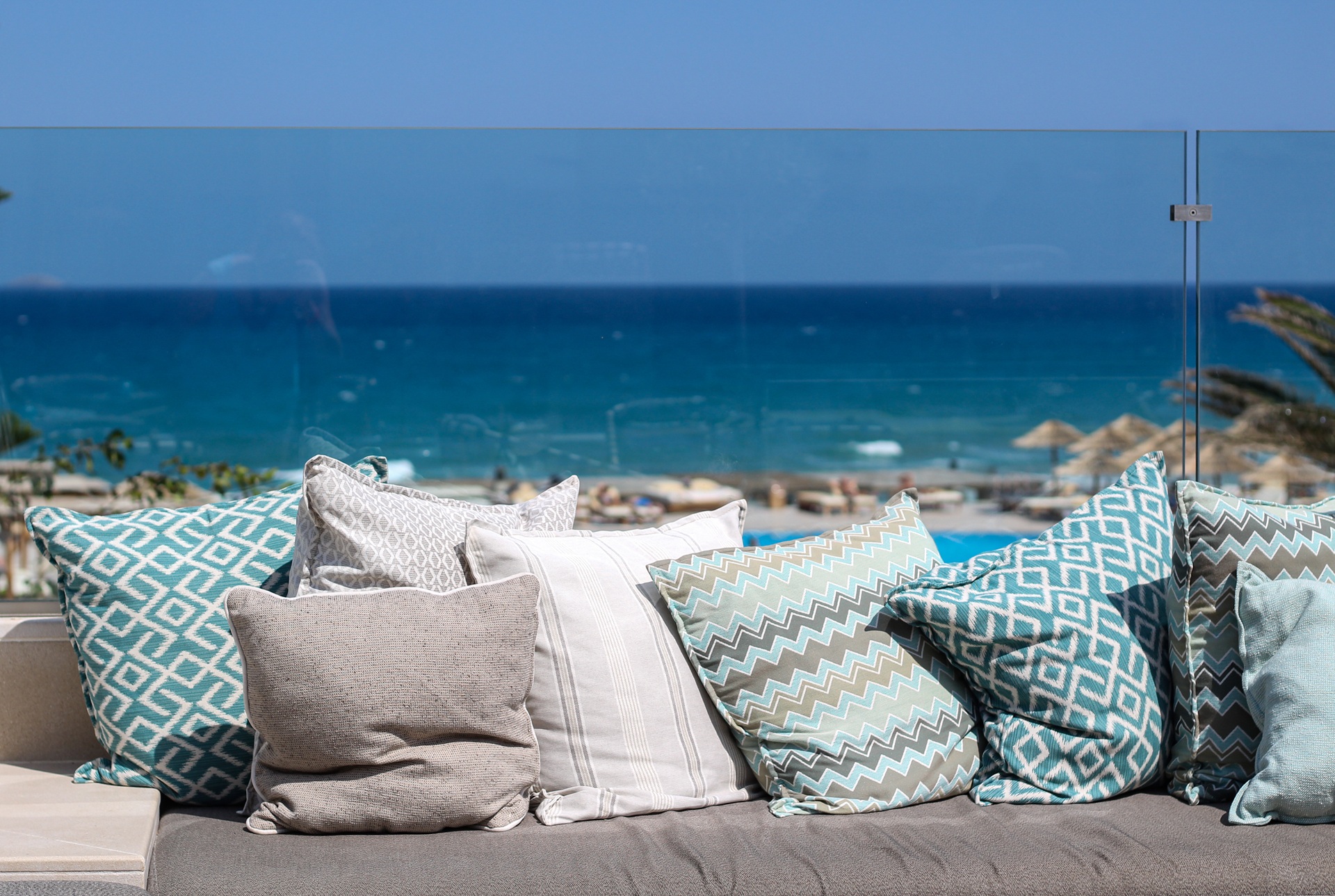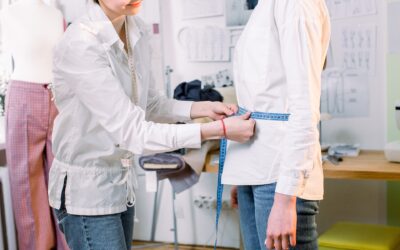Was there a time when your “waterproof” patio cushions soaked up rain like a sponge or when your so-called “water-resistant” pillows ended up with water rings after just a light drizzle? If, indeed, there was, you’re definitely not the first to wonder what those labels really mean. Although these terms sound similar, they actually mean very different things when it comes to outdoor fabrics.
To clear up this confusion once and for all, we look into the real differences between water-resistant and waterproof cushions—what those terms mean, how they perform in real-world weather, and most importantly, how each type should be cleaned and cared for. Because the more you know about your fabric, the better you’ll be at preventing wear, weather damage, and early replacement.
How Waterproof and Water-resistant Cushion Fabrics Actually Compare
The label on your outdoor cushions might say “resistant” or “proof”—but those two words mean very different things. One can handle a drizzle, the other can handle a downpour. Here’s a clear breakdown to help you know what you’re working with and how to care for it properly.
| Feature | Water-resistant Fabrics | Waterproof Fabrics |
|---|---|---|
| Level of Protection | Repels light moisture (dew, mist, gentle drizzle). | Completely blocks moisture—even heavy rainfall. |
| Fabric Construction | Usually breathable materials like treated canvas, polyester blends, acrylic textiles. | Non-breathable synthetic materials like vinyl, heavy-duty polyester with waterproof backing, or coated textiles. |
| Seams | Typically sewn, allowing some water seepage over time. | Usually heat-sealed, taped, or welded to ensure no moisture penetration. |
| Breathability | Good airflow, which helps prevent trapped moisture, but may allow water penetration. | Minimal to no breathability—excellent moisture blocking, but susceptible to internal condensation. |
| Cleaning Considerations | Requires gentle cleaning and thorough drying to avoid mold and mildew buildup. | Easier to clean, can often be wiped down quickly, but harsh cleaners can degrade waterproof coating. |
| Drying Time | Takes longer to fully dry since moisture can seep into fibers or foam. | Dries quickly on the surface since moisture doesn’t penetrate deeply. |
| Comfort and Feel | Generally softer and more comfortable due to fabric flexibility and breathability. | Sometimes stiffer, less plush feel due to coating or heavier synthetic fabrics. |
| Best for Which Use? | Covered patios, screened porches, or sunny outdoor areas where moisture is minimal. | Exposed outdoor areas, rainy climates, boats, poolside furniture, or areas with frequent moisture exposure. |
| Typical Longevity and Wear | May degrade faster if frequently exposed to moisture without drying properly. | Longer-lasting in wet conditions, provided waterproof coating remains intact. |
Key Takeaways to Remember:
- Water-resistant cushions are great for patios or outdoor areas that are mostly dry, as long as you stay on top of cleaning, drying, and care routines.
- Waterproof cushions are your best options for uncovered spaces, rainy climates, or high-moisture environments, making maintenance simpler but at the cost of breathability and a softer feel.
- Always consider your local weather, exposure to elements, and willingness to maintain cushions properly when making your choice.
Why Cleaning Water-resistant vs. Waterproof Cushions Requires Different Approaches

If your cleaning method leaves water spots, stains, or lingering odors, it might be because you’re using the wrong approach for your cushion type. Water-resistant fabrics tend to be more porous and need gentler, moisture-conscious cleaning. Waterproof cushions, on the other hand, can handle more aggressive wiping but trap heat and moisture inside. That’s why recognizing the difference is key to keeping your cushions clean and long lasting.
1. Water-resistant Cushions Are Absorbent—So Moisture Management Is Critical
Unlike waterproof cushions, water-resistant cushions allow some moisture to seep in, especially through seams or untreated fabric areas. This means you need to be extra cautious about drying thoroughly after cleaning.
- They absorb water slowly, which means drying time takes longer.
- Any leftover moisture can lead to mold, mildew, and musty odors inside the foam.
- Thorough rinsing and full sun drying are non-negotiable after cleaning with soap, detergent, or vinegar solutions.
- Avoid over-saturating them during cleaning to prevent deep foam absorption.
2. Waterproof Cushions Have Sealed Barriers—So Harsh Scrubbing Can Break the Seal
Waterproof cushions are often coated in vinyl or treated polyester, with seams that are heat-welded or taped to prevent leaks. That’s great for keeping the inside dry—but tough on durability if cleaned too aggressively.
- They can be wiped down with a damp cloth, sponge, or soft brush—no need for deep soaking.
- Using abrasive cleaners, bleach, or stiff brushes can weaken the waterproof coating and reduce effectiveness.
- These cushions are ideal for quick hose rinses, especially when dealing with mud, pollen, or bird droppings.
3. Different Cushions React Differently to Cleaners
Whether you use soap, vinegar, borax, or hydrogen peroxide, how the fabric responds depends on its water resistance level.
- Water-resistant fabrics are usually more breathable and may be sensitive to strong chemicals.
- Waterproof cushions can handle more surface-level cleaning but may be damaged by heat or certain detergents.
- Always spot test in a small area first, especially with outdoor upholstery cleaners or sprays from Amazon or local stores.
4. Drying Methods Must Match Cushion Type
Drying is where a lot of cushion care goes wrong—and it all comes back to knowing the fabric.
- Water-resistant cushions must dry completely to prevent internal mold. Use a towel to blot, then air dry in sunlight.
- Waterproof cushions can simply be wiped dry or air dried without much worry, thanks to their sealed barrier.
- Never use steam cleaning, high heat, or machine drying unless the manufacturer specifically says it’s safe.
Best Cleaning Methods for Water-Resistant and Waterproof Cushions
No matter how careful you are, patio cushions attract dirt, pollen, sunscreen, bird droppings, and even the occasional glass of spilled wine. But before you break out the hose or reach for a random cleaner under the sink, it’s important to match your cleaning method to the type of cushion you have—water-resistant or waterproof.
Water-resistant Cushions
Water-resistant cushions are more breathable and absorbent, so moisture can soak in during cleaning. That means you need to go easy on water and prioritize thorough drying after each wash.
Here’s how to safely clean water-resistant cushions:
- Vacuum first: Use a vacuum cleaner to remove loose dust, dirt, and pollen before applying any moisture.
- Use mild detergent or laundry soap: Mix warm water with a small amount of laundry detergent or dish soap.
- Apply with a sponge or soft-bristled brush: Scrub gently in circular motions to lift dirt and stains without oversaturating the fabric.
- Rinse lightly with a garden hose: Use low pressure to rinse out soap without driving water deep into the foam.
- Dry in full sun: Place cushions upright or on their side and rotate them every few hours to allow airflow on all sides.
CAUTION: Avoid bleach, pressure washers, and steam cleaning. These can degrade fabric and lead to water retention inside the cushion.
Waterproof Cushions
Waterproof cushions are sealed or coated to prevent water from penetrating, which means they can handle quicker and easier cleaning routines. That said, the coating can wear down if you use the wrong tools or cleaners.
The best way to clean waterproof cushions includes:
- Vacuum first: Use a vacuum cleaner to remove loose dust, dirt, and pollen before applying any moisture.
- Wipe down with a damp microfiber cloth: Ideal for regular cleaning of oil, sunscreen, or light dirt.
- Spray mild soap solution: Use a spray bottle filled with water and gentle detergent or soap to treat surface stains.
- Rinse with a garden hose: A light rinse won’t harm the interior since the seal blocks water absorption.
- Spot treat stains with hydrogen peroxide or vinegar: Use a diluted solution (test first!) to remove wine, mildew, or bird mess.
- Dry with a towel or air dry: Because they repel water, a simple wipe with a towel usually does the trick.
CAUTION: Avoid scrubbing too hard or using abrasive brushes. That protective coating is what keeps them waterproof—and once it’s gone, so is the barrier.
Quick Comparison of Cleaning Methods
| Cleaning Step | Water-resistant Cushions | Waterproof Cushions |
|---|---|---|
| Vacuum First? | Yes | Yes |
| Mild Soap + Water? | Yes (use carefully, avoid soaking) | Yes (spray and wipe) |
| Scrubbing? | Light scrub with soft brush | Light pressure only; avoid abrasion |
| Rinsing Method? | Light garden hose rinse | Garden hose okay; avoid pressure washers |
| Drying? | Full sun drying, rotate often | Towel dry or air dry is usually enough |
| Deep Stain Treatment? | Vinegar, borax (test on hidden area) | Vinegar, peroxide (gentle application) |
Not Sure How to Clean Your Outdoor Cushions? Send them to Columbus Dry Cleaning & Laundry Services for Safe and Meticulous Cleaning—Call Us Today!
Water-resistant or waterproof, your cushions deserve expert care—and Columbus Dry Cleaning & Laundry Services is here to deliver it. Whether you’re dealing with mildew, red wine stains, pollen, or dirt buildup from unpredictable Ohio weather, we understand the unique cleaning needs of every fabric, fiber, and foam core of outdoor cushions. Our team uses top-of-the-line equipment and gentle, effective solutions to clean your outdoor cushions the right way—without compromising their durability or appearance.
Have questions or want to schedule a service? Reach out to us—our team will respond within 24 hours.




